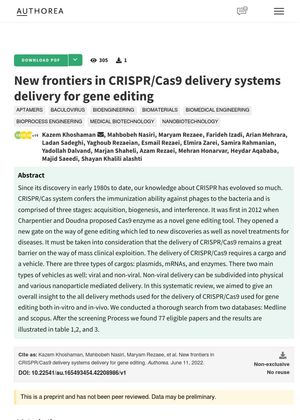New Frontiers in CRISPR/Cas9 Delivery Systems for Gene Editing
June 2022
in “
Authorea (Authorea)
”

TLDR Efficient delivery systems are needed for the clinical use of CRISPR-Cas9 gene editing.
The document is a detailed review of various CRISPR-Cas9 gene editing delivery systems, focusing on delivery vehicles and cargos. The cargos include DNA plasmid, Cas9 mRNA, and Cas9 – gRNA endonuclease complex, while the vehicles are classified into non-viral vectors, viral vectors, and physical delivery. The study identifies complications such as off-target side effects and the requirement of a PAM sequence at the targeted locus. The document also explores different delivery methods, each with its own pros and cons, including electroporation, microinjection, hydrodynamic injection, mechanical cell deformation, iTOP, GONAD, TRIAMF, CPP, nanoparticle delivery, and DNA nanostructures. It further discusses potential carriers like aptamers, gold nanoparticles, nanodiamonds, carbon nanodots, and lipid nanoparticles. The document concludes that the lack of efficient delivery systems has hindered the clinical use of Cas9 gene editing, and further research is needed to determine the efficacy and safety of these methods for clinical use.